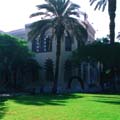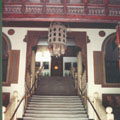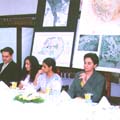|
Cairo, the largest urban center in the Arab world and Africa, lies in the Nile Valley where it begins to broaden into the fertile delta. One of the world's oldest cities, Cairo is inheritor and protector of many traditions -- pharaonic, ancient Greek and Roman, Coptic, Islamic and Arabic. It is at the same time a contemporary center for international development and Middle East policy.
The American University in Cairo is located on Tahrir Square in downtown Cairo, near government ministry buildings, hotels and commercial areas, the National Cultural Center, and the Egyptian Museum. The campus (see map inside the back cover) covers parts of five city blocks. Gracefully situated on the main campus are a converted palace, outdoor basketball and tennis courts, gardens, and a fountain area. The original university building, which opened in 1920, was constructed as a palace in the 1860s for the Minister of Education Khairy Pasha. The building briefly became the headquarters of the Egyptian University (now Cairo University) in the early 1900s and was acquired by AUC in 1919. The palace now houses central administrative and faculty offices and a number of classrooms.
Additions constructed on the main campus between 1927 and 1932 include Ewart Memorial Hall, one of the most culturally active auditoriums in Cairo; Oriental Hall; and wings on either side which house the English and Comparative Literature Department, and the English and Arabic Language Institutes. Two other buildings were added later to the main campus, Hill House; built in 1952, now serves as a student center, and the six-story Science and Engineering building was completed in 1966.
Located a half block from the original campus, the "Greek" campus was acquired in the 1960s. It contains the university's social science departments, the Jameel Management Center (added in 1989), the Center for Adult and Continuing Education, a cafeteria, the 330-seat Wallace Theater, and the university's library (added in 1982).
Other sections of city blocks near the main campus contain AUC classrooms, student services, offices, and a special collection and rare books library. Two AUC buildings located further from the core campus group include a ten-story dormitory in the Zamalek area of Cairo providing housing for students and faculty, and a building in the Heliopolis area used primarily for continuing education classes. AUC also has an extensive housing program for relocated faculty and staff. In 2001 a major new academic center building was completed on the Falaki campus. This multi-story building is designed primarily for new classrooms and faculty offices and includes a new theatre for performing and visual arts productions and other events. AUC has designed a new campus, which will be built on a site that the university has purchased in the "New Cairo" development area. The preliminary target dates for moving the new campus is 2006. |




